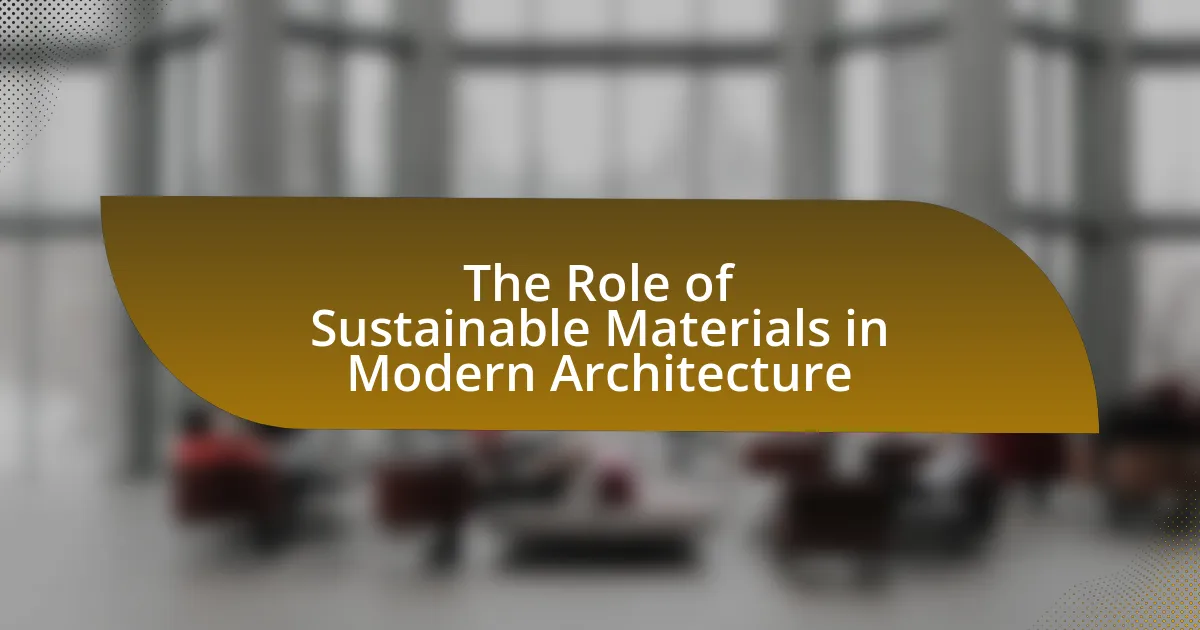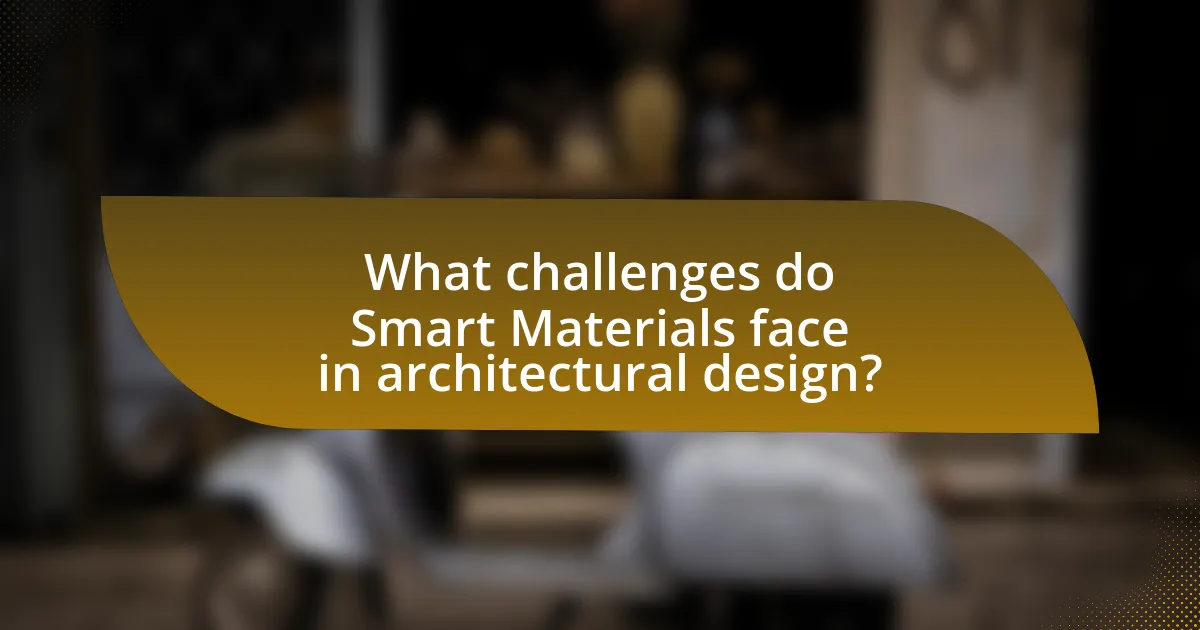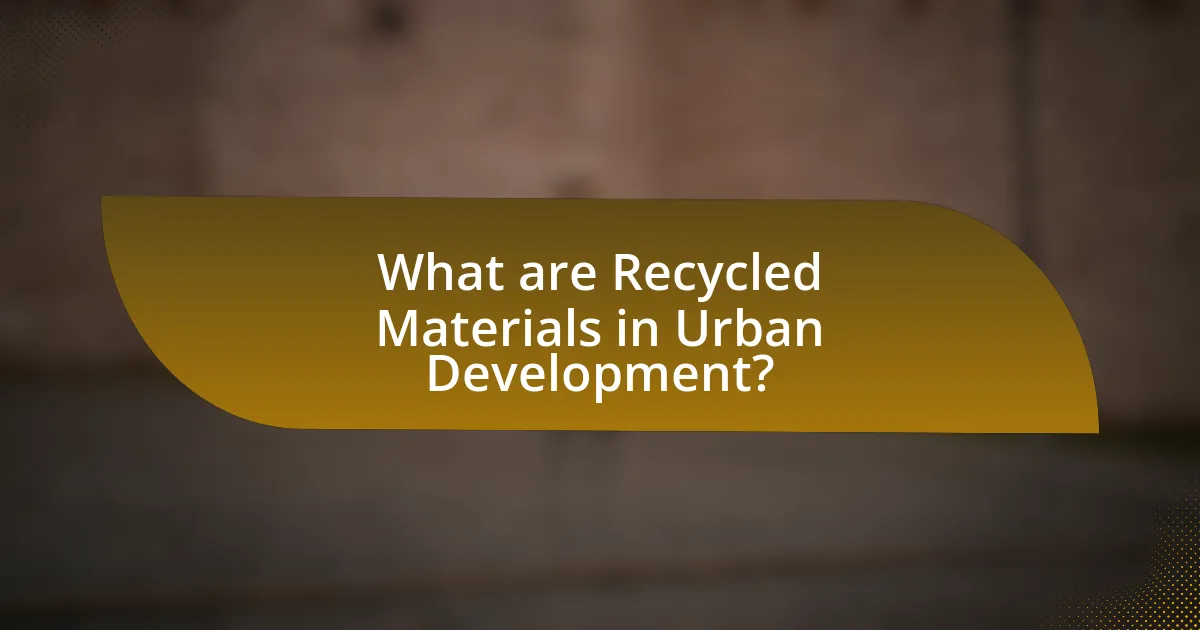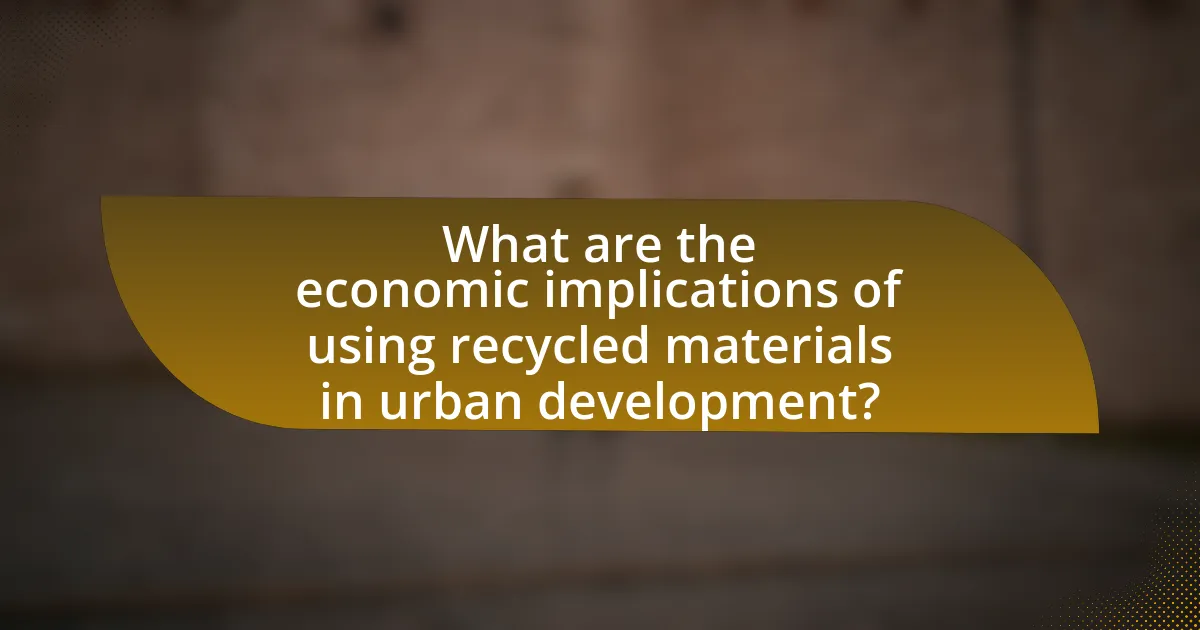The article focuses on understanding the thermal properties of various building materials, which are crucial for energy efficiency, comfort, and durability in construction. Key thermal properties discussed include thermal conductivity, thermal resistance, specific heat capacity, and thermal mass, each influencing how materials conduct, store, and insulate heat. The article highlights the impact of these properties on building performance, energy efficiency, and sustainability, emphasizing the importance of selecting appropriate materials based on their thermal characteristics. Additionally, it covers methods for measuring thermal properties, the significance of insulation, and best practices for material selection tailored to specific climates and locations.

What are the Thermal Properties of Building Materials?
The thermal properties of building materials refer to their ability to conduct, store, and insulate heat. These properties include thermal conductivity, thermal resistance, specific heat capacity, and thermal mass. Thermal conductivity measures how easily heat passes through a material; for example, metals have high thermal conductivity, while insulators like wood and foam have low thermal conductivity. Thermal resistance indicates a material’s ability to resist heat flow, which is crucial for energy efficiency in buildings. Specific heat capacity defines the amount of heat required to change a material’s temperature, affecting how materials respond to temperature changes. Lastly, thermal mass describes a material’s ability to absorb and store heat, influencing indoor climate stability. Understanding these properties is essential for selecting appropriate materials for energy-efficient and comfortable buildings.
How do thermal properties influence building performance?
Thermal properties significantly influence building performance by affecting energy efficiency, comfort, and durability. Materials with high thermal mass, such as concrete and brick, can absorb and store heat, leading to reduced temperature fluctuations and lower energy consumption for heating and cooling. Conversely, materials with low thermal conductivity, like insulation, minimize heat transfer, enhancing energy efficiency and maintaining indoor comfort. Studies indicate that buildings designed with optimal thermal properties can reduce energy costs by up to 30%, demonstrating the critical role these properties play in overall building performance.
What specific thermal properties are most important for building materials?
The specific thermal properties most important for building materials are thermal conductivity, thermal resistance, and specific heat capacity. Thermal conductivity measures how well a material conducts heat; lower values indicate better insulation properties, which is crucial for energy efficiency in buildings. Thermal resistance, often represented as R-value, quantifies a material’s ability to resist heat flow; higher R-values signify better insulating performance. Specific heat capacity indicates the amount of heat energy required to raise the temperature of a unit mass of the material; materials with high specific heat can absorb and store heat, contributing to temperature regulation within buildings. These properties are essential for optimizing energy efficiency and comfort in building design.
How do thermal properties affect energy efficiency in buildings?
Thermal properties significantly influence energy efficiency in buildings by determining how well materials retain or dissipate heat. Materials with high thermal mass, such as concrete or brick, can absorb heat during the day and release it at night, reducing the need for heating and cooling systems. Conversely, materials with low thermal resistance, like single-pane glass, allow heat to escape easily, leading to increased energy consumption for climate control. Studies indicate that buildings designed with optimal thermal properties can reduce energy use by up to 30%, demonstrating the critical role of these properties in enhancing overall energy efficiency.
Why is it essential to understand thermal properties in construction?
Understanding thermal properties in construction is essential because they directly influence energy efficiency, comfort, and durability of buildings. Thermal properties, such as thermal conductivity, thermal resistance, and specific heat capacity, determine how materials respond to temperature changes, affecting heating and cooling requirements. For instance, materials with low thermal conductivity, like insulation, help maintain indoor temperatures, reducing energy consumption and costs. Studies show that buildings designed with optimal thermal properties can achieve energy savings of up to 30%, highlighting the importance of these properties in sustainable construction practices.
What role do thermal properties play in sustainability?
Thermal properties significantly influence sustainability by determining how materials manage heat, which affects energy consumption in buildings. Efficient thermal properties, such as high thermal mass or insulation, reduce the need for heating and cooling, leading to lower energy use and greenhouse gas emissions. For instance, materials with high thermal mass can absorb and store heat, stabilizing indoor temperatures and minimizing reliance on HVAC systems. This efficiency contributes to sustainable building practices by enhancing energy performance and reducing environmental impact.
How can knowledge of thermal properties impact design decisions?
Knowledge of thermal properties significantly impacts design decisions by influencing material selection, energy efficiency, and overall building performance. For instance, materials with high thermal mass, such as concrete, can absorb and store heat, leading to reduced energy consumption for heating and cooling. This is supported by studies indicating that buildings designed with appropriate thermal properties can achieve energy savings of up to 30% compared to conventional designs. Additionally, understanding thermal conductivity helps architects and engineers optimize insulation strategies, ensuring comfortable indoor environments while minimizing energy costs. Thus, integrating thermal property knowledge into design processes enhances sustainability and functionality in building projects.

What Types of Building Materials Have Distinct Thermal Properties?
Types of building materials with distinct thermal properties include concrete, brick, wood, glass, and insulation materials. Concrete has high thermal mass, allowing it to absorb and store heat, which helps regulate indoor temperatures. Brick also exhibits similar thermal mass properties, providing energy efficiency in temperature regulation. Wood, being a natural insulator, has lower thermal conductivity, making it effective in reducing heat transfer. Glass, particularly low-emissivity glass, can reflect heat while allowing natural light, contributing to energy efficiency. Insulation materials, such as fiberglass and foam, are specifically designed to minimize heat transfer, enhancing energy conservation in buildings. These materials are chosen based on their thermal properties to optimize energy efficiency and comfort in construction.
How do natural materials compare to synthetic materials in terms of thermal properties?
Natural materials generally exhibit superior thermal properties compared to synthetic materials, particularly in terms of insulation and heat retention. For instance, materials like wood and straw have lower thermal conductivity, which allows them to retain heat more effectively than many synthetic alternatives such as polystyrene or fiberglass. Studies indicate that natural materials can provide better thermal comfort in buildings, as they tend to regulate temperature fluctuations more efficiently. Additionally, natural materials often have higher specific heat capacities, meaning they can absorb and store more heat energy, contributing to energy efficiency in construction.
What are the thermal properties of wood as a building material?
Wood as a building material has notable thermal properties, including low thermal conductivity, high thermal resistance, and good insulation capabilities. These properties allow wood to effectively resist heat flow, making it an energy-efficient choice for construction. Specifically, wood’s thermal conductivity ranges from 0.10 to 0.20 W/m·K, which is significantly lower than that of materials like concrete or steel. This low conductivity helps maintain stable indoor temperatures, reducing heating and cooling costs. Additionally, wood’s ability to absorb and release moisture contributes to its thermal performance, enhancing comfort levels in buildings.
How do concrete and masonry materials perform thermally?
Concrete and masonry materials exhibit significant thermal mass, which allows them to absorb, store, and release heat effectively. This property helps in moderating indoor temperatures, reducing energy consumption for heating and cooling. For instance, concrete has a thermal conductivity of approximately 1.7 W/m·K, which enables it to retain heat during the day and release it at night, thus stabilizing temperature fluctuations. Additionally, masonry materials, such as brick, have similar thermal properties, with a thermal mass that can enhance energy efficiency in buildings. Studies have shown that buildings constructed with these materials can achieve up to 30% energy savings compared to those built with less thermally efficient materials.
What are the thermal characteristics of insulation materials?
Insulation materials possess thermal characteristics that primarily include thermal resistance (R-value), thermal conductivity (k-value), and specific heat capacity. The R-value measures the material’s resistance to heat flow, indicating its effectiveness as an insulator; higher R-values signify better insulation performance. Thermal conductivity quantifies how easily heat passes through a material, with lower k-values indicating superior insulating properties. Specific heat capacity refers to the amount of heat energy required to change the material’s temperature, influencing how insulation materials respond to temperature fluctuations. These characteristics are critical in determining the energy efficiency of buildings, as effective insulation reduces heat loss in winter and heat gain in summer, ultimately leading to lower energy consumption and costs.
How does the R-value relate to insulation effectiveness?
The R-value quantifies insulation effectiveness by measuring its resistance to heat flow; higher R-values indicate better insulating properties. For example, materials with an R-value of 30 provide significantly more thermal resistance than those with an R-value of 10, making them more effective at reducing heat transfer. This relationship is critical in building design, as it directly impacts energy efficiency and comfort levels within structures.
What types of insulation materials are available and how do they differ thermally?
Insulation materials include fiberglass, foam board, cellulose, mineral wool, and spray foam, each differing in thermal performance. Fiberglass has a thermal resistance (R-value) of about 2.9 to 4.3 per inch, making it effective for standard applications. Foam board, with an R-value ranging from 3.8 to 6.5 per inch, provides superior insulation for exterior walls and roofs. Cellulose, made from recycled paper, offers an R-value of approximately 3.2 to 3.8 per inch and is known for its eco-friendliness. Mineral wool, or rock wool, has an R-value of about 3.0 to 3.3 per inch and is fire-resistant, making it suitable for high-temperature areas. Spray foam insulation, with an R-value of 6.0 to 7.0 per inch, expands to fill gaps, providing an airtight seal and superior thermal performance. These variations in R-values indicate how well each material resists heat flow, influencing their effectiveness in different building applications.

How Can Thermal Properties Be Measured and Evaluated?
Thermal properties can be measured and evaluated using techniques such as differential scanning calorimetry (DSC), thermal conductivity tests, and thermal imaging. Differential scanning calorimetry quantifies heat flow associated with phase transitions, providing insights into specific heat capacity and thermal stability. Thermal conductivity tests, such as the guarded hot plate method, measure the rate of heat transfer through materials, yielding values essential for assessing insulation performance. Thermal imaging utilizes infrared cameras to visualize temperature distribution across surfaces, enabling the identification of thermal bridges and insulation deficiencies. These methods collectively offer a comprehensive evaluation of thermal properties, crucial for understanding the performance of building materials in energy efficiency and comfort.
What methods are used to assess the thermal properties of building materials?
Methods used to assess the thermal properties of building materials include the guarded hot plate method, the heat flow meter method, and the transient plane source method. The guarded hot plate method measures thermal conductivity by maintaining a temperature difference across a sample and measuring the heat flow. The heat flow meter method involves placing a heat flow sensor on one side of the material to determine thermal resistance. The transient plane source method uses a heat pulse to analyze thermal conductivity and diffusivity by monitoring temperature changes over time. These methods are standardized by organizations such as ASTM International, ensuring their reliability and accuracy in evaluating thermal performance.
How do laboratory tests measure thermal conductivity?
Laboratory tests measure thermal conductivity by utilizing methods such as the guarded hot plate method, the transient plane source method, and the heat flow meter method. In the guarded hot plate method, a sample is placed between two plates, one heated and the other cooled, allowing for the measurement of heat flow through the material to determine its thermal conductivity. The transient plane source method involves placing a heat source in contact with the sample and measuring the temperature response over time, which provides data to calculate thermal conductivity. The heat flow meter method uses a heat flux sensor to measure the rate of heat transfer through a material, enabling the calculation of thermal conductivity based on the temperature difference across the sample. These methods are standardized by organizations such as ASTM International, ensuring accuracy and reliability in the measurement of thermal conductivity for various building materials.
What is the significance of thermal imaging in evaluating building materials?
Thermal imaging is significant in evaluating building materials as it allows for the detection of heat loss, moisture intrusion, and insulation effectiveness. This technology provides a visual representation of temperature variations, enabling professionals to identify areas where building materials may be underperforming. For instance, studies have shown that thermal imaging can reveal insulation gaps in walls and roofs, which can lead to energy inefficiencies and increased heating or cooling costs. By using thermal imaging, building inspectors can make informed decisions about material performance and necessary repairs, ultimately enhancing energy efficiency and structural integrity.
How can thermal performance be improved in existing buildings?
Thermal performance in existing buildings can be improved by enhancing insulation, sealing air leaks, and upgrading windows. Improving insulation, such as adding or replacing insulation in walls, attics, and floors, can significantly reduce heat loss; studies indicate that proper insulation can reduce energy consumption by up to 30%. Sealing air leaks around doors, windows, and other openings prevents drafts and maintains indoor temperatures, which can lead to energy savings of 10-20%. Upgrading to energy-efficient windows, such as double or triple-glazed units, can further enhance thermal performance by minimizing heat transfer, with potential reductions in heating and cooling costs of 15-25%.
What retrofitting options enhance thermal efficiency?
Retrofitting options that enhance thermal efficiency include adding insulation, upgrading windows, and installing energy-efficient heating and cooling systems. Insulation, such as spray foam or fiberglass, reduces heat transfer, thereby maintaining indoor temperatures and lowering energy consumption. Upgrading to double or triple-glazed windows minimizes heat loss and improves overall energy performance. Energy-efficient heating and cooling systems, like heat pumps, utilize less energy compared to traditional systems, further enhancing thermal efficiency. These retrofitting measures collectively contribute to reduced energy costs and improved comfort in buildings.
How can building orientation and design optimize thermal performance?
Building orientation and design can optimize thermal performance by strategically positioning structures to maximize natural light and minimize heat loss. For instance, orienting buildings to face south in the Northern Hemisphere allows for greater solar gain during winter months, reducing heating costs. Additionally, incorporating design elements such as overhangs can provide shade in the summer, decreasing cooling demands. Research indicates that buildings designed with passive solar principles can reduce energy consumption by up to 30%. This evidence supports the effectiveness of thoughtful orientation and design in enhancing thermal efficiency.
What Best Practices Should Be Followed for Selecting Building Materials?
Best practices for selecting building materials include assessing thermal properties, durability, sustainability, and cost-effectiveness. Evaluating thermal properties is crucial as materials with high thermal mass can help regulate indoor temperatures, reducing energy consumption. For instance, materials like concrete and brick have high thermal mass, which can enhance energy efficiency in buildings. Additionally, selecting durable materials minimizes maintenance costs and extends the lifespan of the structure. Sustainable materials, such as recycled or locally sourced options, contribute to environmental conservation and may qualify for green building certifications. Cost-effectiveness should also be considered, balancing initial investment with long-term savings on energy and maintenance. These practices ensure that the selected materials meet performance requirements while aligning with environmental and economic goals.
How can one choose materials based on climate and location?
To choose materials based on climate and location, one must assess the thermal properties of materials in relation to local weather patterns and environmental conditions. For instance, in hot climates, materials with high thermal mass, such as concrete or brick, can help regulate indoor temperatures by absorbing heat during the day and releasing it at night. Conversely, in cold climates, materials with good insulation properties, like wood or insulated panels, are preferable to minimize heat loss. Research indicates that buildings designed with climate-appropriate materials can reduce energy consumption by up to 30%, demonstrating the importance of selecting materials that align with specific climatic conditions.
What are the common mistakes to avoid when selecting building materials for thermal efficiency?
Common mistakes to avoid when selecting building materials for thermal efficiency include overlooking insulation properties, neglecting the thermal mass of materials, and failing to consider the climate. Insulation properties are crucial; materials with low thermal conductivity, such as fiberglass or foam, enhance energy efficiency by reducing heat transfer. Ignoring thermal mass can lead to poor temperature regulation; materials like concrete or brick can absorb and store heat, stabilizing indoor temperatures. Additionally, not accounting for the local climate can result in inappropriate material choices; for instance, materials suitable for hot climates may not perform well in cold regions. These considerations are essential for optimizing thermal efficiency in building design.






































